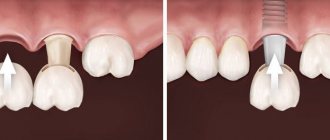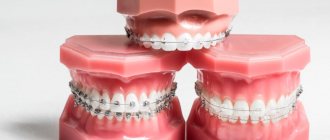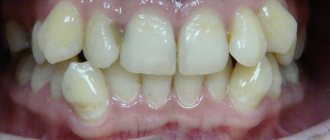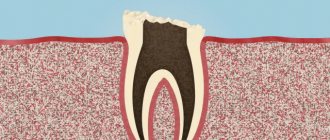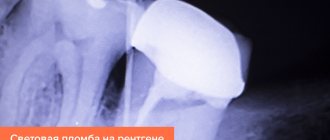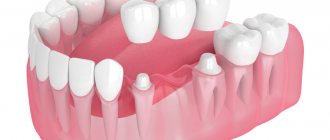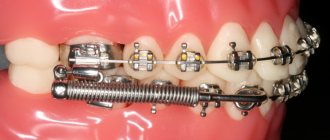To replace one or more lost teeth, dentistry offers 2 methods: implantation or installation of braces to shift adjacent teeth into the defect area. Both procedures are the same in price and time. You can choose a method only after X-ray diagnostics. The condition of the bone tissue, the length and location of the defect are taken into account.
What is the essence of the methods?
Braces
Braces are orthodontic structures for correcting bites and moving teeth into the correct position. They are an arch with ligatures, dental clasps for fixation, made of metal, plastic, ceramics. There are:
- vestibular - installed on the outside of the teeth;
- lingual - fixed on the inside and not visible to others.
The purpose of the structures is to create pressure to move the tooth into the desired position.
The tooth root is connected to the bone tissue by ligaments. Under pressure they stretch, the crown and root parts move. The duration of treatment is determined individually, ranging from several months to several years.
Implantation
Implantation is a method of replacing a lost tooth with a titanium root and then installing an artificial crown on it.
The operation is performed under local anesthesia or sedation. The gums are peeled off, a hole is drilled in the bone tissue, into which a titanium rod is screwed. The implant is covered with gum, sutured and left alone until it engrafts with the bone. With classic two-stage implantation, the period lasts 3-6 months. After osseointegration, a crown is installed.
If there is not enough bone tissue, it is augmented before or during implantation. If osteoplasty is performed as a separate stage, it will take another 3-6 months for the bone material to heal.
How do braces work?
Naturally, the doctor works with each patient individually. There are many types of braces, as well as many types of malocclusions. Already during the consultation, it becomes clear what problem is relevant and how to solve it.
How do braces work? After choosing a design, the doctor will carefully place the lock in the desired position on each tooth. Here it is important to take into account not only the position of individual teeth, but also the condition of the entire row. After all, even a small change in the position of one element leads to a displacement of all the others. Therefore, it is extremely important to configure everything correctly.
During treatment, the patient must regularly visit the doctor for preventive and corrective examinations. As the correction progresses, the doctor will gradually move the braces, adapting them to the new position of the teeth.
Is it possible to get braces instead of implants?
Moving adjacent teeth into the socket of the removed one is a common alternative to implantation. In terms of timing and price, these procedures differ little. Not all orthodontists undertake such treatment; experience and skills are required. In our Center, orthodontic treatment is used to replace a lost tooth, but the choice of method depends on:
- number of missing units - the distance to which adjacent teeth will need to be moved is estimated;
- location of the defect - frontal or chewing zone;
- the age and health of the patient - the possibility of performing an implantation operation and the effectiveness of orthodontic treatment are assessed;
- quality and quantity of bone tissue in the area of missing teeth - if there is not enough bone, bone augmentation is carried out during implantation; installation of braces is not always possible in such a situation.
Braces allow you to avoid implantation if one of the distant dental units (molar or premolar) is missing. The teeth adjacent to the missing one move and close the gap. But the method is not suitable if the frontal unit is removed, since the front teeth differ in shape. In this case, implantation will be required, which can be combined with the installation of braces to correct the dentition.
If the patient already has braces installed and a tooth needs to be removed, existing structures are used.
Related articles:
- Center guarantees
- Our advantages
- Press about us
What problems does installing braces solve?
The orthodontist at the ViDentis clinic will examine you and, based on your clinical situation, offer several options for braces at a cost that is acceptable to you. We provide orthodontic treatment for the following indications.
- Too wide interdental spaces are an aesthetic problem that spoils the smile.
- Crowding of teeth - pathogenic microflora develops in the cracks between teeth and caries forms.
- Incorrect position of teeth in a row - they can be deployed, growing in different directions, for example, towards the cheek.
- Disproportions in the development of the jaws - for example, a shorter or protruding lower jaw prevents normal chewing.
Clinical situations
If orthodontic treatment is required
If a patient is missing one tooth and requires orthodontic correction of the dentition, it is better to opt for braces - this way the teeth will be in the correct position and at the same time the space will be closed. No surgical intervention is required, there are no contraindications and there is less risk to health.
But this option is suitable if one of the distant teeth is missing. If there is a lack of anterior or several dental units, implantation is indispensable. Before installing implants, braces are first put on. To maintain space for the titanium root, a spring is attached to the adjacent teeth, holding them at the desired distance. An artificial root can also be inserted during orthodontic treatment - during the period of wearing braces, the implant will take root.
If the dentition is straight
If the dentition is straight or has already been treated with braces, it is better to install an implant, since the teeth are already in the correct positions. This treatment will require surgery, but will be faster than wearing braces. If implantation is not possible for any reason, repeated orthodontic treatment is carried out.
Despite the patient’s wishes, the final decision on whether to pull out a tooth with braces or place an implant remains with the doctor.
How do the doctor and patient evaluate the result of the correction?
- The patient looks at the problem locally and only wants to straighten his teeth so that he can show off his smile without embarrassment. But long-term local defects in the dentition lead to the formation of a global problem - malocclusion.
- Therefore, the orthodontist sees his task not only in straightening the dentition, but also in achieving physiological closure of the teeth of the upper and lower jaw or maintaining a normal bite, which can be disrupted during the alignment of teeth only at the bottom or at the top.
Unfortunately, in the vast majority of cases, single-jaw braces do cause unwanted side effects or lead to unstable results in the long term. How will a patient who paid specifically for an aesthetic result, no matter how he imagines it, react to this? Of course, he won’t say thank you for his protruding teeth, and he certainly won’t remember that he saved 50% on the installation of turnkey braces.
Therefore, a decent doctor, when planning treatment, always assesses the risk of deterioration of the dental system and further progression of pathology, which is possible when correcting teeth only in the upper or only in the lower row. And in practice, there are cases when savings actually become possible.
What is cheaper - braces or implants with crowns?
Both methods cost approximately the same price.
In our Center, the cost of implantation consists of 3 items:
- Surgical stage. Provides manipulations for the introduction of a titanium pin with the inclusion of the necessary materials and services of an implantologist in the price. Cost - 65-85 thousand rubles.
- Crown installation. When the implant takes root, a crown is installed on it. Its price ranges from 48 to 55 thousand rubles, depending on the production technology.
- Bone growth. If the bone tissue is thinning, it will require preliminary extension, which will cost from 24 thousand rubles.
Total: the cost of implanting one tooth is from 137 thousand rubles.
During orthodontic treatment to replace one dental unit, row correction involves installing braces on both jaws. Options and combinations of designs differ, which is why the price ranges from 62-127 thousand rubles per jaw (the most expensive are made from sapphire). When installing braces on both jaws, the price doubles.
Total: to install the cheapest braces on both jaws you will need 124 thousand rubles.
What type of braces do we offer?
Most of the systems we work with are self-ligating - specially designed clasps are used as fastenings, in which the orthodontic arch can move freely. If you place such braces on your teeth, you will be able to wear them as comfortably as possible, the treatment time will be reduced by 1.5 times, and you will need to visit the orthodontist less often to correct the system.
Installation of In-Ovation braces
The advantage of self-ligating braces from the world's top manufacturer Dentsply Sirona (USA) is their miniature size, so they do not affect diction or interfere with chewing.
- In-Ovation R is a metal system that is reliable and affordable.
- In-Ovation C is a ceramic system that looks as aesthetically pleasing as possible due to the transparency of the material.
- In-Ovation L is a lingual system, fixed on the inside of the teeth, the braces are miniature in size, so they are completely invisible from the outside.
Installation of Damon braces
The American company Ormco has been developing dental braces for adults and children since 1960. The “brackets” do not have sharp corners; getting used to them takes no more than 2-3 days.
- Damon Q and 3MX are metal systems suitable for any, even the most complex, malocclusions.
- Damon Clear - sapphire braces made of aesthetic and durable material, ideal for the upper jaw, as they are almost invisible.
- Damon 3 are combined systems where elements are made of ceramics, metal and plastic.
In our Center, we apply the principles of an integrated approach when planning treatment.
For the process to be successful, the patient receives consultation from several specialists. The process involves an orthodontist, an implantologist, and an orthopedist. They draw up a joint treatment plan, taking into account the volume of the bone, the distance between the teeth for the implant and the crown. If you do not take into account these nuances, you will have to re-install braces.
Levin Dmitry Valerievich
Chief physician, Ph.D.
It is important to consider how long ago the tooth was removed:
- If a tooth has been missing for a long time, and the neighboring ones have changed position and left no room for an implant, orthodontic treatment is aimed at freeing up space for an artificial root and crown.
- If implantation is planned after the braces are removed, a spring is placed on the adjacent teeth to prevent them from approaching each other and to leave space for the implant.
- If an implant is already in place and its position interferes with tooth movement, orthodontic treatment becomes more difficult. When trying to move an artificial root, there is a risk of its rejection, the development of inflammation, and tissue injury.
Correction process
You can install braces on the upper jaw at the best price at the A-Medic clinic. Our specialists have many years of experience in bite correction and regularly undergo training in innovative techniques.
Treatment of malocclusion pathologies begins with a consultation with an orthodontist. You can make an appointment with a specialist at the clinic directly on the dentist’s website or by phone. After consultation, the patient undergoes diagnostics, treatment (if indicated) and a preparatory procedure (professional cleaning).
After the preparatory stages are completed, the patient visits the orthodontist’s office to take impressions from which the structure will be made.
At the next appointment, the braces system is installed. The doctor glues the plates, passes the arc, tightens and fixes it. Throughout the treatment, which can last up to 1.5 years, the patient periodically visits the doctor to monitor the processes of correction of defects in the upper dentition.
Question answer
Is it always possible to use braces to move teeth to the place where they were removed?
If one tooth is missing, you can do without implantation. But usually this is only possible if there is a shortage of chewing units (provided there is sufficient bone tissue). They differ little in function and form. If there are missing front teeth, implantation will be required. Frontal units vary in size and shape; their displacement will cause an aesthetic defect in the smile area.
Levin Dmitry Valerievich
Maxillofacial surgeon, chief physician of the Center
2 by 4 braces system
This is the name of a common method of attaching braces for the treatment of mixed dentition in children: the orthodontic system is installed on 2 molars and 4 incisors (hence the name). The recommended age for a child to have braces installed is 8-10 years. Braces can be placed on the upper or lower jaw, or on both at once.
Indications for installing a partial 2 by 4 bracket system:
- one or a pair of teeth growing incorrectly, causing discomfort to the child;
- too large interdental gap (often happens in children between the front incisors);
- lack of space for erupting teeth;
- early removal of baby teeth - this can later lead to malocclusion.
Installing partial braces will not help completely correct the bite, since all permanent teeth have not erupted. The 2 by 4 system is often a preparatory stage before wearing a full brace system. Considering that the enamel of children's teeth at this age is not yet strong, it is not recommended to install a partial system for a long time. In addition, children are usually not very careful about dental hygiene without proper supervision, and insufficient care of braces can lead to complications, such as caries.
After the permanent lateral teeth erupt, the partial bracket system is removed, and to maintain the result, the doctor installs a retainer - a special orthodontic splint that controls the position of the permanent teeth.
Installation of dental implants
Two Astra Tech dental implants (Sweden) were installed. These are reliable implants that have been installed at Dial-Dent for more than 15 years. Astra Tech implants perfectly into bones due to the quality, as well as modern materials and technologies used in their manufacture.
After 4 months it was possible to begin dental prosthetics.
Dial-Dent specialists who restored the beauty of your smile
- Orthopedic dentist A.S. Ivankov - treatment planning, coordination of specialists’ work, dental prosthetics with ceramic crowns.
- Orthodontist M.P. Sleptsova - treatment with braces, preparation for dental prosthetics.
- Implant surgeon V.P. Alaverdov – installation of dental implants.
- Osteopathic doctor V.V. Bystrov – osteopathic correction during the period of occlusion correction.
- Dentist-therapist T.I. Matienko – treatment of dental caries, treatment of canals with a microscope.
- Dental hygienist E. Smirnova – professional dental hygiene.
- Dental technician D.V. Wolf – making dental crowns from ceramics.
- Dental assistants – S. Shchelkova, A. Antoshkina, M. Erkimbekova.
See other examples of the work of Dial-Dent specialists here.
Make an appointment for a consultation by phone +7-499-110-18-04 or through the form on the website. You can ask questions about dental prosthetics to the chief doctor of the clinic, Sergei Vladimirovich Tsukor, at
When is it necessary to remove teeth before braces?
Sometimes there really is no alternative to deletion. Moreover, it is not the third molars that have to be removed, but completely different teeth.
Sometimes patients come for a consultation with an orthodontist with straight teeth, but a so-called “convex profile” that prevents them from even closing their lips. In such cases, the removal of “fours” and/or “fives”, first and second premolars helps to correct the situation with both appearance and bite. Removal is performed in pairs - according to indications, in one or both jaws.
What dentures are used in the absence of teeth?
Types of designs:
- Acrylic dentures. The basis (base) is a plastic base made of acrylic plastic. Suitable for complete edentia.
- Nylon, where the base is nylon. This is an elastic material. The main feature of this design is quick adaptation. Suitable for complete edentia.
- Clasp - consist of cast openwork metal. More durable, stronger than the previous two options. Suitable when there are several immobile teeth in the mouth.
- Prosthetics on implants. Implants are first installed in the bone, and then an orthopedic structure is attached to them.
Do not self-medicate, consult a doctor!
Don't wait for your condition to worsen!
Sign up
All dentures in the absence of teeth are selected individually. The doctor assesses the situation in the oral cavity and offers solutions to the problem. We recommend visiting a consultation with an orthopedic doctor to receive complete information about prosthetics in your case.
OUR ADVANTAGES
Any types of braces
We use all types of orthodontic structures and will select the optimal one for you.
Staged payment
The price of treatment consists of two fixed amounts: installation of braces and scheduled appointments.
Experienced specialist
Consultation and treatment with braces is carried out by an orthodontist who specializes in solving complex cases.
Predicting the result
Thanks to the use of 3D technology, the patient receives straight teeth within the promised period.
Cost of treatment
| Name | Price, rub) |
| Metal self-ligating braces (USA) 1 jaw | from 60,000 ₽ |
| Ceramic self-ligating braces (USA) 1 jaw | from 75,000 ₽ |
| Lingual braces (USA) 1 jaw | from 220,000 ₽ |
| Activation of the bracket system 1 jaw | from 3,000 ₽ |
*Prices are for one jaw.
